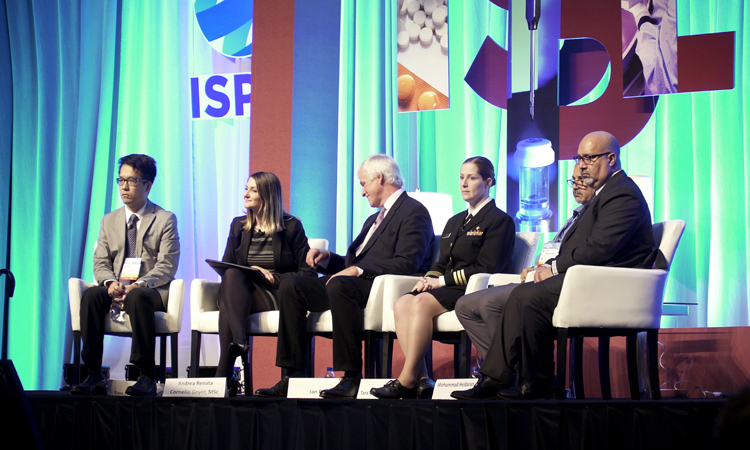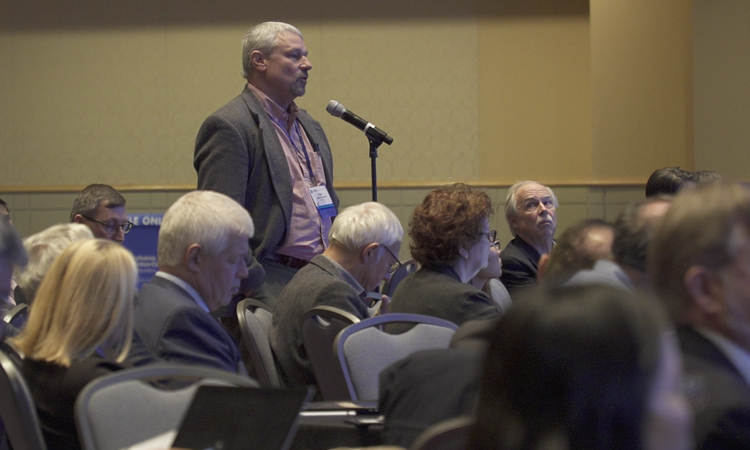Three Approaches to Emerging Therapies - Global Regulatory Town Hall

Regulators from three global agencies—US FDA, MHRA, and Brazil’s ANVISA—discussed how their agencies are addressing emerging therapies during the “Global Regulatory Town Hall” on 6 November at the 2018 ISPE Annual Meeting & Expo.
“Precision medicine excites us and scares us,” said Frank Montgomery, PhD, Global Head, Regulatory CMC, AstraZeneca, who served as the session lead. “It means faster development. We’re able to look at targets we couldn’t in the past, and that means more complex products, be they synthetic, biology, or cell-based.” The development of combination products to effectively deliver these drugs, combined with uncertainty about the number of patients who will receive them, adds to the complexity presented by precision medicine.
As a result, interaction and partnership with regulators is “incredibly important” for those who are developing emerging therapies such as precision (or custom) medicine because those conversations can develop a framework with a drive to quality and innovation, Montgomery said. An additional challenge: “If we are really putting patients first, we have a responsibility to ensure availability of those medicines beyond the countries that can afford to pay for them.” This includes driving down manufacturing costs and creating an environment that allows for this.

FDA’S Emerging Technology Team Program
Sau (Larry) Lee, PhD, Director and Emerging Technology Team Chair, Office of Testing and Research, FDA/CDER/OPQ, provided information about the agency’s Emerging Technology program and its achievements since launching in 2014.
The program was created to encourage and support the adoption of innovative technology through close collaboration with industry and other relevant stakeholders. The Emerging Technology Team (ETT) is intended to be a central location for inquiries about novel technologies, and to support innovation by providing a forum for early interaction with FDA, Lee said.
Early engagement is key, and can begin during technology development, even without an identified drug candidate, Lee said. Recently published final guidance1 details what is needed, but Lee noted it begins with a five-page proposal containing a brief description and background, including why the proposed technology is substantially novel and unique for consideration in the program. “It is important and your responsibility to make a sufficient argument to show your technology is sufficiently novel,” Lee said. “We’re looking for the disruptive technology.”
Since the program began, over 30 requests have been accepted into the Emerging Technology Team program, Lee said. Over 60 interactions have occurred, and more than half of these related to continuous manufacturing (CM). Other areas explored include multi-attribute mass-spectroscopy methods and novel container and closure system for injectable products.
“Our research won’t replace company programs,” Lee said. “The purpose is to increase our knowledge level such that we can ask the questions and focus on high-risk areas.” The goal is more effective quality evaluation and facilitating approval under an accelerated timeline, he added. In fact, Lee noted that some CM requests are approved ahead of the timeline. Emerging Technology Team is also collaborating with academic institutions. “We are part of your team and we can work together to overcome some obstacles.”
ANVISA’s Updates
The Brazilian Health Regulatory Agency (ANVISA) is also working to accelerate approval of new technologies. Andrea Renata Cornelio Geyer, Senior GMP Inspector and Expert Regulatory Advisor, Office of Pharmaceutical Inspections, shared regulatory perspectives with attendees.
ANVISA participates in multiple international forums to promote regulatory harmonization, including ICH and the International Coalition of Medicines Regulatory Authorities (ICMRA); the agency is also an applicant for PIC/S, with an audit planned for 2019.
Challenges facing Brazil include backlog and analysis delay, created by multiple requests waiting for analysis and varied timelines, and differences in request, procedures, and reviewers’ practices; these need to be mapped, then removed or clearly stated, and reviewers need to be confident in the process, Geyer said.
To address these challenges, ANVISA has established priority pathways for important drugs and established criteria for eligibility, including pediatric, neglected diseases, emerging or remerging diseases, and serious debilitating conditions. Special procedures for clinical trials authorization, GMP certification, and marketing authorization of new medicines for treatment, diagnoses, or prevention of rare diseases were established.
The agency also set strategies to reduce backlog, including grouping applications to increase reviewers’ productivity, launching a task force to temporarily increase the number of reviewers, and establishing administrative measures to increase productivity. The agency’s backlog was reduced from 845 applications in 2017 to just 45 in October 2018.
ANVISA also simplified post-approval changes with risk-based classification, allowing more changes to be immediately implemented, an approach based on the EMA post-approval guide. In addition, ANVISA optimizes review of biologics already authorized by FDA and EMA.
Future steps will include adopting an API regulatory framework equivalent to that of the European Community, implementing electronic common technical documents for applications submissions; and implementing ICH guidelines about pharmacovigilance.
MHRA’s Innovation Office
The final presenter described the UK’s MHRA Innovation Office and its efforts to accelerate global acceptance through early engagement. Ian Rees, Manager, Inspectorate Strategy and Innovation, noted that the more disruptive types of technologies do not always come from pharma R&D, but from academia and hospitals. Looking at best practices and regulatory is needed to address these disruptive technologies, Rees said.
The Innovation Office was established to make innovation operational: to clarify and “de-risk” new projects and processes. Launched in 2013, the office provides confidential advice to academia, hospitals, industry, and consortia at any stage of development. However, Rees noted, “the earlier, the better.” A version of these services is offered by the One Stop Shop, offering offers a single point of access to free, clear, expert responses to queries about the regulation of regenerative medicines.
Additional initiatives include accelerated access review to identify transformational medicines, devices, and digital products, and Advanced Therapy Treatment Centres, a network of organizations to increase patient access to advanced therapies as well as establish best practices, track and trace systems, data capture, and patient follow-up.
Q & A
Attendee questions were fielded by the presenters as well as additional regulators who joined them to form a panel for responses and discussion. Highlights of the discussions:
Neural Networks and Validation
Answering a question about how to validate neural networks in quality control, Rees suggested engagement and discussion, but offered no specific answers. “We don’t want to be hit on inspection with something that is not good for anybody.” Added Tara Gooen Bizjak, Senior Science Policy Advisor, Office of Policy for Pharmaceutical Quality, FDA/CDER, “This highlights the importance of the ETT. A new platform for multiple products, the idea that is open and available in discussion is good to highlight. It’s not just about a product or single process—it can be a platform approach.”
- 1US Food and Drug Administration. Office of Pharmaceutical Quality. “Process for Evaluating Emerging Technologies Related to Quality.” 19 October 2017. https://www.fda.gov/downloads/AboutFDA/CentersOffices/OfficeofMedicalProductsandTobacco/CDER/ManualofPoliciesProcedures/UCM578020.pdf

FDA Expenditures on Innovation
To a question about reports that significant money has been budgeted for innovation across the FDA, Lee responded that research outside the agency has been funded to develop enabling technology like CM, improve labs and research capabilities within FDA/CDER, and update IT infrastructure. Funds may also be used to hire contractors and subject-matter experts in areas such as modeling.
Mohammad Heidaran, PhD, Biologist, Office of Cellular, Tissue and Gene Therapies, FDA/CBER, addressed the query from the CBER standpoint. “Advanced manufacturing is of interest,” he said. Other areas include internal funding for research and database development, and standardizing acceptance and review of data.
Joint Regulatory Meetings
To a question about more engagement through joint meetings with other regulatory authorities, especially in the areas of gene and cell therapy, Heidaran said that there are a number of ways to interact with stakeholders in cell and gene therapy. In fact, a new program called INTERACT (Initial Targeted Engagement for Regulatory Advice on CBER producTs) is designed for early engagement. “We [also] have ongoing, extensive interaction at the international level, more robust than any time before and being expanded with mutual recognition programs and inspection findings. Globalization is happening as we speak.”
Data Integrity
To a question about what the next quality gap/issue/concern would be once data integrity is “solved,” Carmelo Rosa, Director, Division of International Drug Quality, FDA/CDER responded “One of biggest challenges is how do we address data integrity, and at what point do we feel comfortable to say that it is resolved? Data integrity in injections, assay results not reported or investigated, [if] we overcome that—what’s the next gap? Because a system is not strong in identifying issues, we’re doing investigations, but they are insufficient so then you are dealing with root cause analyses. It just evolves to different areas. How do I address DI not site-by-site but [in a] global or corporate approach [when]we are still finding we resolve an issue at one facility, but we go to another facility and we still find issues.”
He continued, “One area often forgotten with data integrity is the impact on application data—one of the biggest issues we’re dealing with now. Few resources go to this. We’re asking for retrospective review, and sometimes finding companies with approved applications have had to withdraw them because they cannot justify where the result came from.”

Training Within Agencies
To a question about what agencies are doing to enhance understanding of new manufacturing technologies, Rees discussed MHRA’s Horizon-Scanning Working Group with specialized inspectors in areas such as CM, which has meetings and blogs to informally share information, as well as annual symposia.
Lee pointed out FDA’s internal research program to look at CM and other new technology also offers internal training. FDA is partnering with Rutgers University for external research, and has site visit programs to gain knowledge. CM is handled by a specific group within the agency, he said. “We want to train the next generation of reviewers and investigators on this.”
Brexit
In response to a question about continuity of medical supply related to Brexit, Rees demurred, saying that he did not have insights on political discussions, so there was a need to prepare for a range of possible outcomes. “Pragmatism is key word for us—integrity of assessments is all there and we’ll continue to accept that and put pragmatic arrangements in place,” since it is not clear what will happen. including reciprocation by EU27.
Disclaimer: This is brief and informal synopsis of responses from UK MHRA, US FDA, and the Brazilian Health Regulatory Agency (ANVISA) regulators during a panel dialogue at the ISPE 2018 Annual Meeting & Expo. It has not been vetted by any agency and does not represent official guidance or policy of the MHRA, FDA, or ANVISA.



